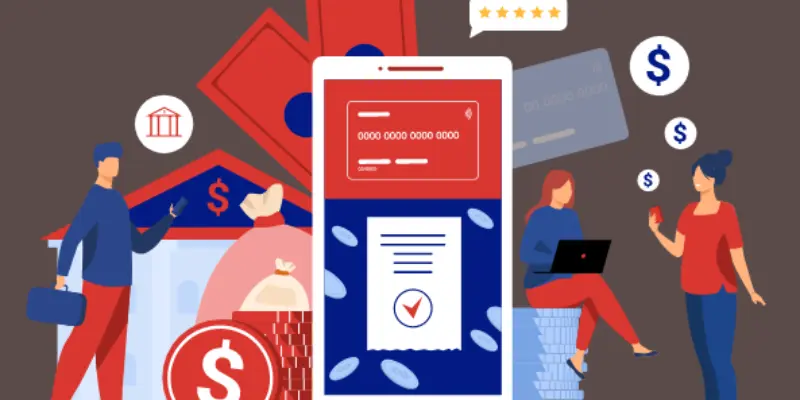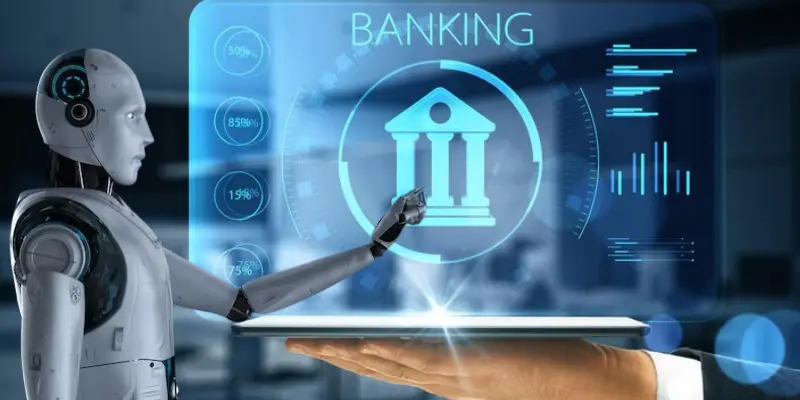South Africa's finance landscape has been rapidly changing recently, and digital banking is a key factor. From online and mobile banking through open banking to financial inclusion and the increasing popularity of fintech based on blockchain, this African digital banking industry is full of potential and innovation. Digital transformation and mobile banking app development promises myriad benefits, such as efficiency, speed, and more accurate user information, allowing banks to provide customers with customized solutions.
Do you know that 42.31% of South Africans use their mobile phones to conduct digital banking? Most South Africans use smartphones, suggesting they depend heavily on the digital banking world. The wide use of mobile phones showcases that the future of digital banking in South Africa is poised to become transformative. The fast acceptance of mobile banking and constant advancements in technology for financial services fuel this change.
In this blog, we'll examine the challenges, trends, and opportunities shaping the future of digital technology in South Africa.
Understanding Digital Banking
Digital Banking is the automated process of traditional banking. It permits a bank's customers to use its products and services through online or electronic platforms. Digital banking digitalizes all banking processes and replaces the bank's physical location with an online presence that is always in place, eliminating the requirement for customers to stop by the branch.
Digital banking lets customers conduct transactions using a variety of digitally secured channels while banks take responsibility for data security, related risk reduction, and other regulatory concerns. It does this by integrating mobile and online banking with cutting-edge technology in social media, analytics, innovative payment options, and mobile technology. This is a way to exceed customers' expectations, ease of use, and satisfaction.
In digital banking, every record is kept in digital form. Data is converted to valuable information using analytical techniques, better customer interaction is available, and more revenue is generated through customer interaction. This results in increased operational efficiency and higher profits for the bank.
Benefits Of Digital Banking
Moving to a more modern and technologically advanced approach to doing business, it is a given that the benefits far exceed the expenses. Digital banking, as a result of technology, is designed to simplify life for those who use banks. Digital banking comes with advantages:
-
Digital banking lets customers complete banking tasks in the privacy of their homes, whether they're an old person fed up with sitting in line, a busy professional working full-time, or an everyday user who doesn't want to travel to the branch for a simple errand. Additionally, it offers the convenience of.
-
One of traditional banks' major negatives was their reliance on paper. Since the introduction of electronic banking as an online service, banks have gone paperless. To enhance the convenience of digital banking, users can conduct banking throughout the day and have 24/7 access to banking features.
-
Digital banking enables a person to automate payment for regular utility bills, including gas, electricity, phones, electricity, and credit cards. Customers no longer have to try to keep track of due dates. They can also choose notifications about upcoming payments as well as unpaid payments.
-
Shopping online has become effortless, and mobile banking app development services are now fully integrated into shopping sites. Internet banking has greatly contributed to the growth of online payment.
-
Digitally accessible banking services for remote locations are the first step in a holistic approach to growth. With affordable smartphones and internet connectivity in rural areas, people can make the most of digital banking options.
-
Thanks to digital banking, users can report or block lost credit cards with the touch of an icon. This huge benefit increases the security and privacy available for banks' customers.
-
Promoting a cash-free society limits the flow of black currency because the government can monitor the movement of money. Over the long term, the digital system will likely reduce the requirements for minting currency.
Technological Advancements Driving Online Banking In South Africa
Technological developments have had a dramatic effect on South Africa's online banking experience. The growing demand for mobile banking for financial transactions is possible due to continuous improvements in the user experience (UX) in these applications. Furthermore, blockchain's ability to enhance security in transactions and AI's capability to deliver customized customer experience are the primary elements of this digital transformation.
Mobile Banking Apps
The situation in South Africa and the rapid development and adoption of mobile banking applications indicate the shift to digital financial services, fueled by customers' desire to access and use services easily. Incorporating advanced security tools, including cryptographic authentication using biometrics, has increased consumer confidence in addressing fraudulent activity. An improved user experience increases the value of the apps.
Top on-demand mobile banking app development in South Africa exemplifies these features with their robust customer service methods, which incorporate chatbots within the app and 24/7 support lines, ensuring rapid resolution of user issues. While the digital banking world evolves with each passing day, advancements to mobile banking apps highlight their impact on creating the future of banking products within South Africa.
AI-Driven Customer Service
Banks across South Africa are leveraging AI to improve efficiency through automation, streamline customer interaction, and cut operational expenses. This technological shift enables banks to offer 24-hour availability to meet the ever-growing demand.
Chatbots, powered by AI and virtual assistants, are at the top of this evolution and provide personalized experiences by studying customer information. They can deal with various questions, ranging from balance checks to more complex transaction disputes, providing high satisfaction levels. Data analytics play a vital function, helping banks gain insight into huge data sets and improve their offerings.
As AI technology develops and advances, it will likely be more integrated with the internet banking system. It will increase productivity through automation and boost customer satisfaction standards within South Africa's banking sector.
Blockchain Technology
Blockchain technology is becoming an essential element in the advancement of banking online across South Africa. It offers enhanced protection, transparency, and reduced fraud. Blockchain integration into banking systems is addressing critical concerns, including data privacy and the integrity of transactions.
Using decentralized finance (DeFi) methods, South African banks can minimize the need for traditional intermediaries, reducing operational expenses and risk associated with centralized systems. The adoption of cryptocurrencies is also gaining popularity as South African financial institutions explore strategies to incorporate digital currencies in their product offerings. The move not only expands possibilities for investment but also improves transborder efficiency.
Evolving Consumer Preferences
With the increasing use of smartphones and connectivity to the internet, South African consumers are quickly moving towards a digital banking experience. This is due to the need for increased customer engagement and better user experience. The substantial increase in bank account use across South Africa suggests an increasing acceptance of digital solutions for financial services.
Security measures are also a major element driving this change. As people become more technologically adept and expect more secure security, the demand for security has increased. However, this is not always good news, as 44% of South Africans are still uncomfortable with the internet for banking. Banks invest more in cutting-edge cybersecurity technology to secure sensitive data and increase consumer trust.
In addition, the focus on the user experience is evident in the user-friendly interfaces for custom mobile banking app development, which emphasize user-friendliness and ease of use. A focus on simplicity and incorporating new features, such as biometric authentication, will ensure that the digital banking experience remains safe and user-friendly, increasing the time consumers spend with it.
Understanding The Power Of Diversification In The Digital Banking Strategy
.webp)
When banks are pondering ways to boost their revenues in the midst of tightening the monetary system, we expect the focus to be on the main options:
Beyond Interest Revenues
They have always sought to increase profitability by diversifying revenues beyond net interest earnings. Because of their size, it's crucial to recognize that established banks have advantages over smaller ones in generating revenue from fees. However, across all sectors, there is a tendency to earn additional revenue by charging fees in various ways, such as wealth management and asset management. To further boost the non-interest-based income component of their portfolios, banks could either purchase or join with fee-based businesses to increase income in this field.
Beyond South Africa
The African banking market is rife with activities - there are several new exits and an increase in market players that are not banks in various markets. Some of the most prominent international banks have exited markets. Pan-African banks have opted for organic growth by expanding their African operations to increase their profits.
This trend is likely to continue. In addition, South African banks will look for opportunities to diversify their income streams, with a particular focus on African markets experiencing robust economic growth and the development of a growing middle class with higher disposable incomes, such as the ones in East Africa.
Beyond The Financial Sector
The new players want to challenge the conventional bank value chain. This can be seen with the rapid growth of embedded financing and other banking initiatives. The growing use of API-based technology allows the creation of partnerships and ecosystem-based propositions.
This allows banks to develop more comprehensive, single-point-of-shopping offerings in various areas, including energy, insurance finance, financial planning, and consumer products and services. We expect a growth in the number of these partnerships, which will enhance the range of services offered beyond traditional banking.
Challenges For Traditional Banks
Traditional banks operating in South Africa face significant challenges, such as adjusting their old technology to modern needs and addressing security risks. However, these issues are offset by potential opportunities, such as using data analytics to boost the customer experience and developing alliances with fintech firms. The dual environment requires banks to be innovative while maintaining regulatory compliance to maintain their competitive advantage.
There's no place where the demand for greater accessibility and inclusive financial services has developed more than in Africa. Over the past decade, rapid commercial activity growth and globalization have made the need for more inclusive financial services increasingly important. The growing number of small to medium enterprises and entrepreneurial activity in several African nations and the accompanying growth in fintech, particularly blockchain technology, have the potential to drive an improvement in the finance infrastructure all over the world.
A further area of need for growth is low-cost and efficient crossing-border payments that facilitate intra-African trade and trade with countries outside the continent. One option to fulfill the need for intra-Africa can be found in the Pan African Payment and Settlement System (PAPSS). It facilitates instant payments across borders across African nations but without the hassle, effort, and expense required for these payments to be made by traditional bank methods.
By using PAPSS, customers are not required to change their local currency into the hard currency to save money and lengthy intermediary processes when they make a payment to someone from another African country. A widespread acceptance of PAPSS throughout the continent is expected to change how payments are made across Africa and help boost economic activity growth.
Given the inherently volatile nature of cryptocurrency, the real promise to increase financial inclusion in Africa lies in the infrastructure of blockchain that supports them more than the actual currencies. The stablecoins are a distant second. Distributed ledger technology will instantly eradicate errors and fraud from transactions and improve transparency of financial records. This will help to create corruption-resistant and strong welfare systems that are robust and resistant to corruption.
Additionally, it can provide methods for transparent and fair microfinance and more purchasing power to facilitate the growth and development of smaller enterprises serving communities. Blockchain technology can open innovative trade possibilities between nations, allow Africans to participate in the technological revolution, and become an integral part of the decentralized economy.
Top Digital Banking Trends 2024
Customers today seek feelings of loyalty, compassion, and emotional connections with companies. Most customers believe it's a moment for companies to rethink their operations and contribute to society. Therefore, banks must expand their perspectives and enhance their digital experiences by connecting with customers. Learn more here about the digital banking trends expected to be booming in 2024.
Open Banking
Although the API economy is in the making within the banking industry, it certainly has great potential for developing more innovative and enhanced financial services. This makes it one of the leading global banking trends.
The simplest way to describe it is that open banking permits banks to share data on financial transactions with tech-forward businesses through APIs (Application Programming Interfaces), which are dependent on the user's approval. It will also allow banks to work with financial institutions outside the banking industry and allow customers access to many banking services through the same platform.
Customer Experience Is Everything
Customers want to be understood, and for banks, they want to meet their financial goals with the highest efficiency level. Banks must improve their understanding, provide individualization, use data to drive their decisions, and anticipate customers' needs by utilizing an app for mobile banking. Banking institutions that take this view into their digital transformation journey will remain dominant in the marketplace.
Developing a Consistent Ecosystem
One of the issues with contemporary digital banking is inconsistency. Traditional banks undergo the process of digitization in stages. It's led to the dispersion of the user experience throughout their system. Graphic elements on applications and websites appear and act differently.
The internet banking websites, ATMs, and apps Each have a distinctive design that is not matched. For example, banks have several investment, payment, and card management apps. The bank also create a mobile banking application that combines all of these functions. Each features a distinct interface and design. The UX is completely different from the one on the site.
Customers expect that all channels provide the same experience when using the internet for banking. A unified experience helps ensure smooth transfers as customers switch between various banks.
Cybersecurity And Fraud Detection
In digital banking, security, and fraud detection have become increasingly important. As banks increasingly rely on the internet and platforms, the threat of cyber attacks and fraud has increased. Secure safeguards are vital to protect customers' private data and avoid financial loss.
One of the most prominent developments in cybersecurity is biometric authentication. The technology uses unique physical features, like facial recognition or fingerprints, to confirm identities and stop unauthorized access to bank accounts. Biometric authentication is gaining popularity because it is safe and practical.
Machine learning and artificial intelligence have also transformed cybersecurity. These tools detect patterns and abnormalities in consumer behavior, allowing them to spot and prevent cyberattacks. AI-powered systems can detect and flag suspicious transactions, significantly reducing the chance of loss due to fraud and financial losses.
Use Of Embedded Finance
Embedded Finance is completely transforming the banking sector by integrating the financial sector with non-financial platforms. This allows banks to increase their offerings through digital ecosystems, thus expanding their market and getting new clients. Numerous banks are exploring the possibility of embedded finance.
In 2024, embedded finance is expected to impact the finance industry significantly, allowing banks to offer more readily available and personalized financial offerings. Banks can serve as general-purpose providers and embed white-labeled products within open ecosystems, concentrate on specialized market segments, and customize their offerings for specific platforms and clients. Embedded Finance promotes a dynamic, consumer-centric, customer-focused financial system that benefits consumers and companies.
Cybersecurity And Fraud Detection
Cybersecurity and fraud detection are top priorities in today's digital banking environment. With banks increasingly relying on online channel security, the possibility of fraud and cyberattacks has increased. Integrating strong security measures will also impact the mobile banking app development cost. Strong security precautions are required to protect sensitive customer data and avoid financial loss.
One of the major developments in cybersecurity is the implementation of biometric identification. This method uses distinctive physical features like fingerprints to confirm identities and stop unauthorized access to bank accounts. Biometric authentication has become popular because it is safe and practical.
Machine learning and artificial intelligence are also revolutionizing cybersecurity. They detect patterns and abnormalities in customer behavior to spot and avoid cyberattacks. AI-powered systems can detect suspicious transactions and flag them as such, significantly reducing the chance of financial loss and fraud.
Digital Identity And ID Wallets
Digital Identities enable secure and authentic identification and authentication through digital channels while protecting users' privacy and allowing them to control their personal information. Particularly for developing nations, Digital ID can promote the growth of all people. However, implementing Digital Identity also plays a crucial role in other countries. According to research, nations implementing a reliable digital ID could unlock an economic value of up to 6% of their GDP in 2030. This underscores the benefits of Digital ID.
Increased Collaborations With Fintech Companies
Traditional banks are increasingly cooperating with fintech companies to bring digital technology into their business. Traditional banks are usually too big to be digitalized relatively quickly, so the digitization process in phases has led to dispersion. Banks can also collaborate with fintech firms and startups to provide their clients with new technology and ease of use. These partnerships could be for a variety of reasons.
Decentralized Finance (DeFi)
The next major trend in digital banking is the popularity of Decentral Finance (DeFi). Since businesses and consumers require more control over their purchases, DeFi platforms have become alternatives to traditional banks. Blockchain technology allows peer-to-peer credit, borrowing, and trading without intermediaries. The result is that users can manage their money and possibly reduce fees and speedier transaction times.
A different aspect of this development is incorporating artificial intelligence within DeFi applications that will improve the customers' experience. AI instruments are used to assess risk in fraud detection, risk assessment, and personalized financial advice so customers can easily use the maze of financial products. The tools also help streamline processes and increase trust with customers who are skeptical of the security and stability of decentralized platforms.
Additionally, changes in regulation influence DeFi. When financial institutions and governments begin to define clear rules on decentralized finance and encourage people who previously were hesitant by creating a safe environment. The trend towards DeFi will grow and create new possibilities for innovative banking and how we handle our money.
Conclusion
Technological advances, changing consumer preferences, and a constantly evolving regulatory framework will significantly affect the future of digital banking across South Africa. Traditional banks will face formidable obstacles and lucrative opportunities while negotiating this changing world, while startups and hire mobile banking app developers remain at the forefront of innovation. The relationship between customer expectations and regulatory frameworks is crucial to determining the future direction of digital banking. It will also begin a major transformation within the banking sector.
Digital Banking services that have a significant impact now and in the near future, will be the ones created by not just using the latest technology but also through the collaboration of traditional banks that are incumbent and central bank regulators to address issues that hinder access to financial services both inside as well as outside of Africa in a truly large size. In the end, the goal is to help sustain growth in the economy and to develop South Africa.












Share this blog